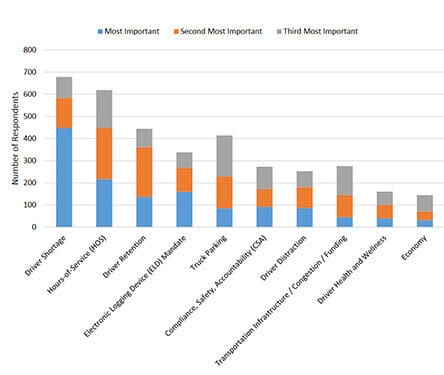The commercial trucking industry is facing a driver shortage that impacts costs and customers. Any company trying to move goods faced a 9.4 percent increase in long-distance trucking costs this summer over the same time last year. It was the biggest price hike in nearly a decade according to the Labor Department.
Hiring good employees is difficult in almost any industry, but the trucking industry has its own unique, complicated hurdles that make it especially challenging to pull in the right people and keep them on the payroll. In fact, truck driver positions are expected to be one of the top 10 most difficult jobs to fill.

Carriers have listed this as their top concern for the second year in a row in the American Transportation Research Institute’s 2018 survey. Driver retention was listed as the third biggest issue facing companies right now; moving up two spots from last year’s survey.
The American Trucking Association (ATA) says that Class 8 truck drivers deliver more than 70% of U.S. goods, and the industry needs to hire almost 900,000 drivers over the next decade to maintain the current workforce if current trends continue.
Given the fact that the trucking industry has struggled with truck driver shortages for the last 15 years, filling those positions won’t be an easy feat. The driver shortage has more than doubled since 2005 when the industry was short 20,000 drivers.
The ATA’s 2017 Truck Driver Shortage Analysis says the industry needs more than 50,000 new drivers on the road right now to meet current demand. The report predicts that shortage will jump to 175,000 drivers by 2025; not taking into account the potential effects automated trucking could have on the industry.
There are a lot of things that have added to the current driver shortage, but one of the biggest factors is the relatively high average age of the existing trucking workforce. The median age of an over-the-road trucker is 49; compared to 42 years old for all U.S. workers. In fact, 25% of drivers are age 55 or older.
And the median age is even higher in certain sectors of the trucking industry. For instance, the median age of a private fleet truck driver is 52 years old. Researchers say replacing retiring truck drivers will account for nearly half of new driver hires in the next decade.
88% of fleet managers say they get plenty of applicants, but most of them aren’t qualified for the job.
The second biggest factor in the shortage will be industry growth, which accounts for 28% of the new driver hiring demand. However, given the current climate, experts fear that the trucking industry won’t be able to keep pace. And given the hiring standards most carriers follow, it only makes it that much more difficult to meet staffing demands.

Most carriers have strict hiring criteria based on things like driving history and experience. So while 88% of fleet managers say they get plenty of applicants, they also say that most of them aren’t qualified for the job. And the cost of lowering hiring standards can be felt through accidents, increased insurance premiums, and poor CSA scores.
Experts say it doesn’t help that drivers have to be 21 to drive across state lines. Missing out on recruiting people between the ages of 18 and 21 means missing out on a group who doesn’t always go on to get a higher education or join the military. They often end up in construction, retail or fast food since they can start their careers earlier there. Unfortunately, there’s no way for carriers to get around this unless Congress takes up the issue, which it is considering given the dire staffing numbers facing the trucking industry.
There is no easy solution to this problem, but there are ways to combat it. According to officials at the ATRI, advocating for state and federal authorities to develop a graduate CDL program to attract safe, young drivers to the industry would help to make big strides in filling that driver shortfall.
The ATRI reports that nearly a quarter of the carriers surveyed said the industry needs to work with the U.S. Department of Labor to develop a national recruiting program within the next decade. As truck driving is expected to be one of the occupations with the most job growth over a decade, experts say it’s essential that the trucking industry and government agencies work together to fill the growing need.
Researchers suggest that the U.S. Department of Transportation and the Department of Defense work together to equalize and streamline the licensing requirements for the departments. Simplifying licensing requirements would cut out some of the red tape and make it easier for new, qualified truck drivers to enter the hiring pool.
As for help retaining drivers, 34% of carriers surveyed said they want to see some type of resource that outlines retention strategies and best practices based on fleet size and sector. Carriers also want to see more about the relationship between driver compensation and the impact it has on driver productivity.
As payroll makes up about 43% of a company’s operational costs, companies are looking to see if their investment is paying off. Researchers say that while pay is only part of the equation, there’s a lot of evidence that good pay plays a huge role in improving and maintaining driver satisfaction.

Fleet managers say a driver’s health plays a big part in how long the person stays with the company as well. “Driver Health and Well-being” ranked as one of the top 10 biggest concerns fleets have moving forward in the recent ATRI report. Both carriers and drivers want more resources available for drivers trying to take their health seriously.
Those surveyed say they would love to see more exercise facilities and better food choices at truck stops and travel plazas. 56% of carriers and 70% of drivers think this will help lessen the negative impact the occupation can have on your health. They also want to see more up-to-date data on what kind of impact truck driving really has on a person’s health, so they can come up with solutions to combat the effects.
The solutions above may help close the driver shortage gap, but none of them are directly within your control. So what can you do to attract qualified drivers and keep them on staff?
Hiring the right staff is difficult — but it’s critical for any business looking to succeed. It costs a company about 20% of an annual salary to replace someone who was earning $30,000 to $50,000 a year. That means a business loses about $8,000 every time it has to replace someone who was making $40,000 a year.
That’s why it’s important to focus on attracting the right drivers to your company, and it’s about more than offering them a hefty paycheck.
While money plays a huge factor in where the best candidates ultimately choose to work, big paychecks can –and do– get passed over for companies that offer better perks or more stability.
Experts recommend focusing on hiring drivers who fit your company’s culture; not just the ones with the most experience. While it may seem hard to walk away from any eligible candidate given the driver shortage, taking the time to hire the right candidate who will stay and grow with the company for years to come is a worthy investment.
Determine the best words that describe your workplace culture, the most common traits among staff members, and what it takes to be successful in your company. Use that information in job posts to describe your company and the position. Shape recruiting message points and interview questions around those ideas to see how a candidate’s previous actions demonstrated those traits.
For example, if your company prides itself on customer service and its friendly staff, ask job-seekers how they handled a difficult situation in the field or how they’ve gone out of their way to help a customer. If you find that passionate people tend to do best in your company, ask the candidate how they’ve improved their workplace or to describe their greatest accomplishment.

While money plays a huge factor in where the best candidates ultimately choose to work, big paychecks can –and do– get passed over for companies that offer better perks or more stability. Millennial drivers especially, part of a generation that is expected to outpace Baby Boomers as the largest generation in the workforce, are just as interested in what their day-to-day lives will look like while driving for you. They’re also very interested in what a job opportunity will mean for their future. Researchers found that:
Drivers who are serious about their careers say they are less likely to be impressed by flashy gimmicks. They’ll likely be more interested in a company that advertises clear career paths, regular schedules, guaranteed miles, and consistent paychecks.
When discussing benefits, show candidates (in dollars) how much you invest in their education, future, and health through 401k options, health plans, and any educational opportunities. It gives them a better picture of how much you value your staff.
Recruiters say to be on the look-out for job hoppers when reviewing resumes. Ask follow-up questions as to why a driver has worked at several shops if you notice they did it over a relatively short period of time. While it may look like they have an array of experience, it can actually mean that they quickly walk out on jobs. The last thing you want to be is another name on their list.
Companies ultimately save money when they take the time to find the right candidate, even if the recruiting process takes more time and resources. Building up a good staff can be a long, slow process, but having a team of knowledgeable, trained staff members that embody the company’s image is truly invaluable to any business looking to succeed.
Retaining your best drivers is even more important when faced with a driver shortage like this. Good truckers generally have their pick of companies that offer the best pay and perks, but keeping them happy and on staff depends on more than a paycheck.
While the average trucker makes around $40,000, drivers for private fleets can make as much as $73,000. In this competitive job market, drivers expect to have things like:
If you can’t afford big salaries or large annual raises, a bonus structure that rewards drivers who meet performance goals can be effective. ATRI says that motor carriers paid drivers an average of $1,500 in safety bonuses in 2016. Having a reward system in place for drivers based on years of services also encourages them to stay on board while demonstrating that you appreciate the time they’ve worked at the company.
Truck drivers notice when you take those bonuses away though; and it creates a lot of frustration when it is for trival reasons. For instance, there are drivers who report getting their safety bonus taken away because they couldn’t attend a safety meeting; even though they were on the road for the company. Experts say that when you set an expecation that you offer bonuses, you need to deliver on that promise. Pulling bonuses for minor infractions hurts your credibiltiy.
Make sure your drivers know exactly what’s expected of them, and what their job entails. That’s especially important when bringing new drivers in. If a driver walks in expecting one thing but gets something else, it starts things off on the wrong foot and hurts the trust the driver has in his or her employer.
The most important thing to do is to clearly communicate with your staff. Make sure employees understand the mission and feel connected to that goal. If you need them to do something, explain why it’s important and what it does to advance them and the organization. It keeps them engaged and makes the work environment feel more inclusive.
For instance, many drivers feel like equipment decisions are made without any input from them. Drivers say that they don’t always know why these calls were made, or what the new equipment will do to help them. Outlining how equipment like fleet cameras can help them in the event of an accident or explaining why the company needs to switch to ELDs helps drivers better understand the decision and the role each team member plays in the company’s success.
Drivers say they often feel undervalued by management, or that those in charge don’t understand what their jobs entail. Conducting ride-alongs with drivers can give you a better sense of what their day looks like while also showing you what kind of issues drivers can face when interacting with customers or using certain pieces of equipment.
You can also bring drivers into dispatch for a day so they can see what dispatchers are dealing with daily. Drivers can get a better sense of what dispatchers need from them, and how certain tools are used to help fleet operations run smoothly.
Some other options you can consider to get your good employees to stick around:
About 20% of drivers who leave their jobs cite health problems as a factor in their decision. Along with the obvious lifestyle benefits, improving a driver’s health can also mean good things for your company’s safety record.
While the ATRI points out that more current studies are needed, a study in 2014 found that:

While carriers are not responsible for a driver’s health, there are things you can do to make drivers more health conscious. For instance, some large trucking companies are providing drivers with wearable health devices. The devices help drivers track their:
Drivers reported making better choices because they were more aware of their eating and exercise habits.
You can look at offering access to stop-smoking programs, or even just provide information about available programs. Consider offering insurance plans that provide proactive healthcare to employees; providing perks like free yearly health screenings or discounts on gym memberships.
Experts say only about half of all fleets offer some type of wellness programs, and the ones that do often focus on driving safety, so offering something that focuses specifically on keeping drivers healthy is another perk you can use to recruit good people who are serious about their health and career.
At the end of the day; drivers are looking for a good company that treats them and their needs with respect. They’re looking for carriers that value a work/life balance. They’re looking for employers who will do what they promise and don’t play games with their paychecks and bonuses. They want to feel appreciated and be heard when they have ideas. Drivers want to work for companies that value what they bring to the table and see how hard they work to get the job done.
While there are still a lot of factors outside of your control that make it difficult to recruit the right drivers, you still have plenty of tools in your reach to help you recruit and retain good people. Focusing on making your business one that drivers want to work at is one of the best ways to help your recruiting efforts and ensure you have the staff you need to run a successful shop.
Recent Posts
Categories
Stay in Touch
Ready to make fleet management more manageable?